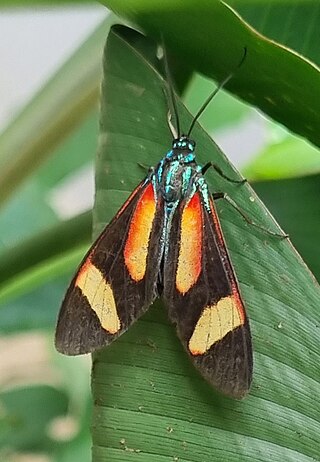
Cyanopepla is a genus of moths in the subfamily Arctiinae. The genus was erected by James Brackenridge Clemens in 1861.

Peridroma is a genus of moths of the family Noctuidae.

Cyanopepla fastuosa is a moth of the subfamily Arctiinae first described by Francis Walker in 1854. It is found in Venezuela and Brazil and on Jamaica.
Cyanopepla agyrtidia is a moth of the subfamily Arctiinae. It was described by George Hampson in 1898. It is found in Bolivia and Ecuador.
Cyanopepla alonzo is a moth of the subfamily Arctiinae. It was described by Arthur Gardiner Butler in 1876. It is found in Colombia, Venezuela and Peru.
Cyanopepla arrogans is a moth of the subfamily Arctiinae. It was described by Francis Walker in 1854. It is found in Mexico, Honduras, Guatemala, Costa Rica, Panama and Venezuela.
Cyanopepla buckleyi is a moth of the subfamily Arctiinae. It was described by Herbert Druce in 1883. It is found in Ecuador and Bolivia.
Cyanopepla glaucopoides is a moth of the subfamily Arctiinae. It was described by Francis Walker in 1854. It is found in Pará, Brazil.

Cyanopepla griseldis is a moth of the subfamily Arctiinae. It was described by Herbert Druce in 1884. It is found in Mexico.
Cyanopepla hurama is a moth of the subfamily Arctiinae. It was described by Arthur Gardiner Butler in 1876. It is found in Ecuador, Bolivia and the Amazon region.
Cyanopepla imperialis is a moth of the subfamily Arctiinae. It was described by Herbert Druce in 1883. It is found in Ecuador.
Cyanopepla jucunda is a moth of the subfamily Arctiinae. It was described by Francis Walker in 1854. It is found in the Brazilian states of Rio de Janeiro and Espírito Santo and in Argentina.
Cyanopepla masia is a moth of the subfamily Arctiinae. It was described by Paul Dognin in 1889. It is found in Ecuador.

Cyanopepla micans is a moth of the subfamily Arctiinae. It was described by Gottlieb August Wilhelm Herrich-Schäffer in 1854. It is found in Colombia and Venezuela.
Cyanopepla panamensis is a moth of the subfamily Arctiinae. It was described by Herbert Druce in 1884. It is found in Panama.
Cyanopepla phoenicia is a moth of the subfamily Arctiinae. It was described by George Hampson in 1898. It is found in Bolivia.

Cyanopepla submacula is a moth of the subfamily Arctiinae. It was described by Francis Walker in 1854. It is found in Mexico, Guatemala, El Salvador, Costa Rica, Panama and Venezuela.
Cyanopepla dognini is a moth of the subfamily Arctiinae. It was described by Gustaaf Hulstaert in 1924. It is found in Paraguay and Brazil.
Phytoecia cinctipennis is a species of beetle in the family Cerambycidae. It was described by Mannerheim in 1849. It is known from Russia, Mongolia, China, and South Korea.

The 1865 Florida gubernatorial election was held on November 29, 1865. Democratic nominee David S. Walker ran completely unopposed and was elected unanimously.






